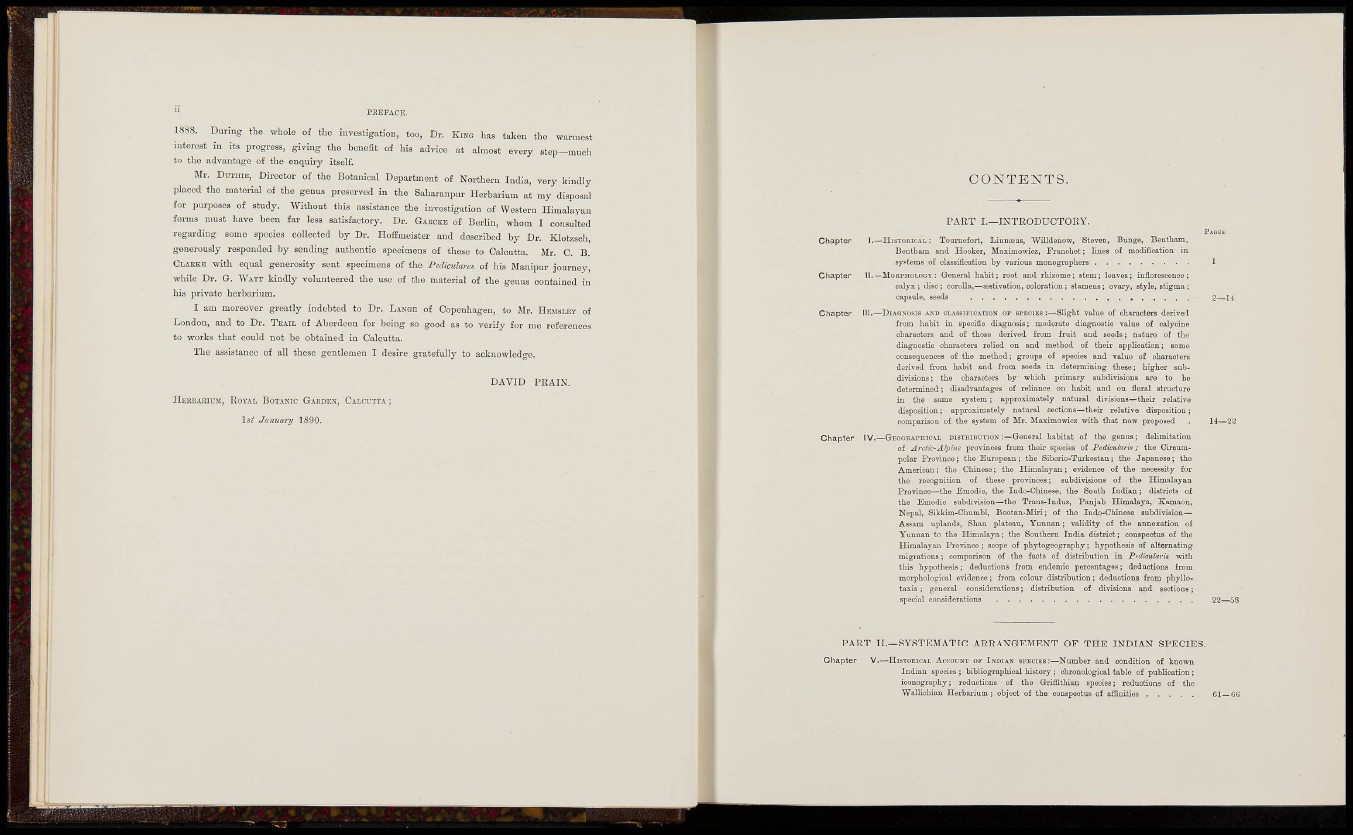
1888. During the Tvhole of the inrestigation, too, Dr. Kmc has taken the warmest
interest m its progress, giving the beneSt of his advice at almost every step-mnch
to the advantage of the enquiry itself.
Mr. DUTHIE, Director of the Botanical Department of Northern India, very kindly
placcd the material of the genus preserved in the Saharanpur Herbarium at my disposal
for purposes of study. Without this assistance the investigation of Western Himakyan
forms must have been fai- less satisfactory. Dr. GAKCKE of Berlin, whom I cotisdtcd
regarding some spocies collected by Dr. HofEmeister and described by Dr. Klotzsch,
generously responded by sending authentic specimens of these to Calcutta. Mr. C. B.
CLASEE with equal generosity sent specimens of the Pedicularcs of his Manipui- journey,
while Dr. G. WATT kindly volunteered the use of the material of the genus contained in
his private herbarium.
I am moreover greatly indebted to Dr. LANGE of Copenhagen, to Mr. HEMSLEY of
London, and to Dr. TKAIL of Aberdeen for being so good as to verify for me references
to works that could not be obtained in Calcutta.
The assistance of all these gentlemen I desire gratefully to acknowledge.
DAVID PRAIN.
HERB^VEIUM, ROYAL BOTANIC GARDEN, CALCUTTA;
1st January 1890.
CONTENTS.
PART I.—INTRODUCTORY.
Chapter I.—HISTORICAL : Toumefort, Linnraus, "WiUdenow, Steven, Bunge, Bentham,
Bentham and Hooker, Masimowicz, Franchet; lines of modifioation in
systems of classification by various monographers
Chapter II.—MORPHOLOGY: General habit; root and ibizome; stem; leaves; inflorescence;
calyx; disc; corolla,—restivation, coloration; stamens; ovary, style, stigma;
capsule, seeds
Chapter III.—DIAGNOSIS AND CLASSIFICATION OF SPECIES :—Slight value of cbaraoters derived
from habit in specific diagnosis; moderate diagnostic value of calycine
cbaraoters and of those derived from fruit and seeds; nature of the
diagnostic characters relied on and method of their apphcation; some
consequences of the method; groups of species and value of characters
derived from habit and from seeds m determining these; higher subdivisions;
the characters by which primary subdivisions are to be
determined; disadvantages of rehance on habit and on floral structure
in the same system; approximately natural divisions—their relative
disposition; approximately natural oeotions—their relative disposition;
comparison of the system of Mr. Masimowicz with that now proposed
Chapter iV.—GEOGKAPHICAL DISTRIBUTION:—General habitat of the genus; dehmitation
of Arctic-Alpine provinces from their species of Pedicularis j the Ciroumpolai
Province; the European ; the Siberio-Turkestan; the Japanese; the
American; the Chinese; the Himalayan; evidence of the necessity for
the recognition of these provinces; subdivisions of the Himalayan
Province—the Emodio, tho Indo-Chinese, the South Indian; districts of
the Emodio subdivision—the Ti'ans-Indus, Panjab Himalaya, Kamaon,
Nepal, Sikkim-Chumbi, Bootan-Miri; of the Indo-Chmese subdivision-
Assam uplands, Shan plateau, Yunnan; validity of the annexation of
Yimnan to the Himalaya; the Southern India district; conspectus of the
Himalayan Province; scope of phytogeography; hypothesis of alternating
migrations; comparison of the facts of distribution in Pedicularis with
this hypothesis; deductions from endemic percentages; doduotions from
morphological evidence; from colour distribution; deductions from phyllotaxis;
general considerations; distribution of divisions and sections;
special considerations
PART II.-SYSTEMATIC ARRANGEMENT OF THE INDIAN SPECIES.
Chapter V.—HISTORICAL ACCOUNT OF IKDIAK SPECIES :—Number and condition of known
Indian species ; bibliographical history ; chronological table of publication;
iconography; reductions of the Griffithian species; reductions of the
"Wallichian Herbarium; object of the conspectus of affinities 61—6(